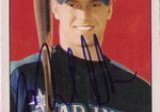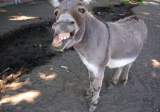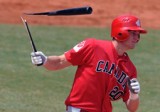Optimism is great Doc, but at the expense of details? What about Saunders month of june(.242,.215,.400) while striking out nearly %25 of the time? His line against LH's .247, .312,.400 doesn't mitigate my doubt. Are there reasons for optimism I'm missing, you never seem to lack for it. ; )
 The Mariners have finally made a major move, and it's with the intention of getting a sneak peak at the future. Wlad Balentien has been designated for assignment and certainly will be traded in order to make room for the Rainiers' best player, Michael Saunders.
The Mariners have finally made a major move, and it's with the intention of getting a sneak peak at the future. Wlad Balentien has been designated for assignment and certainly will be traded in order to make room for the Rainiers' best player, Michael Saunders.
The Skinny: Saunders is a 6'4", 205 pound outfielder who bats left-handed. He's 22 years old and in his fifth year of professional ball (fourth full season) after being drafted in the 11th round in 2005. He was rated the M's #2 prospect before the season by Baseball America.
The Fat: Defensively, Saunders has the speed and arm strength to handle center right now but is considered to be a corner guy long-term. Even still he should be a plus defender in left.
At the plate, he scuffled early in his career, struggling mightily in his first full season of professional ball at 19. However, he has made rapid progress since then and has seen his production dramatically improve despite being promoted aggressively. He is now a complete player, hitting for average, drawing walks and delivering serious power which resulted in a .310/.378/.544 batting line this year in Tacoma. He should be a consistent 30+ homer guy who has an OBP of at least .370. This would make him a legit impact player and a star in the AL.
Now, many would argue that this is a way too optimistic projection, that his overall performance in the minors doesn't justify it. I say that this is mistaken. Despite having a dreadful season at 19 and despite often being placed at least one league higher than he would be if he were in another organization, Saunders' career line is a rock solid .279/.364/.452. If he merely sustained that he'd be well above average offensively. Of course such an overview ignores his precise trajectory which is much more favorable than that suggests. He has clearly improved every year beyond what would be expected of typical player and is now radically better than he was 4 years ago. Furthermore, not only is this season his best year for production, but he has cut down on his strikeouts which was his one big knock.




 It has also been argued that scouts aren't sold on him. This is probably an overstatement. Baseball America has consistently described him as a 5-tool talent and talked up his power while Jason Churchill has similiarly rated him highly. But it is true you won't find scouts who are drooling over him and predicting stardom as I have. However, this is a reflection on the scouts, not Saunders. It is important to understand that if a player is not hyped up when he enters professional baseball, then scouts are very slow to change their projections. BA in particular spends an enormous amount of time and resources covering the draft which means where a guy gets drafted lingers in their writers minds for years afterward. This produces a very telling bias. Allow me to provide one example.
It has also been argued that scouts aren't sold on him. This is probably an overstatement. Baseball America has consistently described him as a 5-tool talent and talked up his power while Jason Churchill has similiarly rated him highly. But it is true you won't find scouts who are drooling over him and predicting stardom as I have. However, this is a reflection on the scouts, not Saunders. It is important to understand that if a player is not hyped up when he enters professional baseball, then scouts are very slow to change their projections. BA in particular spends an enormous amount of time and resources covering the draft which means where a guy gets drafted lingers in their writers minds for years afterward. This produces a very telling bias. Allow me to provide one example.
Jason Bay was drafted in the 22nd, which means he was basically considered org filler on draft day. However, he consistently hit in the minors and in a late season call up mashed .287/.421/.529 in the big leagues. Since he still qualified as a rookie, he was included in BA's Prospect Handbook the following year. Now, you would think that after already punishing major league pitching he'd be a lock to be his orgs #1 prospect, especially in and underwhelming Pittsburgh farm system. Wrong. BA actually rated him THIRD among Pirates prospects, and the two guys ahead of him were 23- and 21-year old pitchers who both had lousy campaigns in Double-A the prior season. They clearly were inferior players to Bay but they were former first round picks and the writer could not get past that even after years of dissapointing performances while Bay was going to be undersold as a guy without much upside (they talk of him as maybe turning into Jeff Conine!). The same goes for Saunders. You won't find a scout who will admit he can hit 30 homers until after he does so. He just doesn't have the right pedigree to get any hype.
In short, he isn't a solid prospect, he isn't a good prospect, he is a GREAT prospect. He is also a perfect fit for this team. He has the range to cover the big left field and the lefty power and patience to tame Safeco. He is going to be a key piece for years to come.
Comments
...but I agree there is definitely reason to wonder about whether Saunders is ready for the majors yet.
Lets just say I disagree.
Maybe in the steroid era, you could expect (expect being the key word here) 30 bombs a year from Saunders. I think 20-25 bombs is much more realistic with a few 30 dinger seasons sprinkled in his prime years is the reasonable projection.
Every hitter has a bad month. I remember when Miguel Tejada in his prime went a month without a homerun. Not sure why that would make you skeptical, then again everyone freaks out when Ichiro bats .280 in April.
As for his numbers against southpaws, that's just nitpicking. It's a small sample so you should expect that to fluctuate a lot. At age 22, Jim Thome had better numbers against lefties than righties; the very next year he was atrocious. Doesn't mean anything. Besides, he's young and so he has plenty of time to get better there. Anyway, even if he never improves in that department, if he slugs .600 against righties I won't complain about a near league average OPS against the occasional lefty.
...in the sense that he'll immediately hit in the majors. Adam Jones and Jeff Clement both showed that just because you destroy AAA pitching doesn't mean there won't be struggles in your first exposure to the big leagues. Regardless, that wasn't the point of my piece. I was talking about his long term upside which I think is very high, higher than the consensus view point.
Hope you submit a good number of articles like the above, Champ. Good stuff.
Spot on w/r/t the fact that org rankings tend to be written so as to justify previous years' commitments. And it's important to keep in mind on Saunders.
On LH platoon splits, I expect *most* young lefty sluggers to take a few years to gain respectability vs LHP. Odd that Saunders was called up to face 5-6 LH starters in a row, because he doesn't figure to help the team much against them.
I've been a huge Saunders booster all along, and I hope he makes the most of his shot.
One thing you don't mention is that Saunders is not just a northern climate guy, he was a multi-sport guy (like Tui) growing up. His Canadian Olympic team bio is here: http://www.nbcolympics.com/athletes/athlete=1522/bio/
Note: youth hockey prodigy, hoops (dunking in high school), soccer, lacrosse. So the guy is:
1. oozing with althetic talent; and
2. "baseball young" -- that is not a guy from a sunny clime who was taking 10,000 ground balls a day year-round at age 11.
So I expect a "learning curve" to continue, and MLB might be a bit much too soon for him, but I think this regime will know that and try to get him in the right spots. Having Langerhans around takes a lot of pressure off.
When he first started gaining notice, I thought he looked like a Jim Edmonds/J.D. Drew type if he maxed out, but Papa is right that fellow Canadian Jason Bay is another good comp.
I don't expect 30 bombs, but 18-25 with 30ish doubles and a good OBP would be plenty good.
So Bay is more of a comp in terms of being a cold-weather atheletic type who moved up the ladder faster than anticipated.
And since we're talking about guys from British Columbia (like Saunders and Bay), here's a slight change of topic, but one more shout out to my new hero, who is having a High Desert-fueled but nevertheless very impressive breakout season, with 2 HR in his last two games:
Tyson Gillies (http://www.youtube.com/watch?v=CQu6xBVfmz8)
357 AB, 122 H, 8 2B, 9 3B, 8 HR, 30 RBI, 50 BB, 65 K, 29 SB, 13 CS, .342/.441/.482/.923
A true lead-off hitter with double-digit triples and scads of patience? Gillies power and BA are enhanced by the freakish Cal League conditions, but still ... gotta keep an eye on him. (And he's a good human-interest story, 25th-round draft pick overcoming being hard of hearing.)
I think that Rickey was quoted as saying he was ready to un-retire at 50 instead of go into the HOF, since he figured he'd be better than most of the leadoff hitters still playing. Any quick thoughts, Doc, on how important it is to have the table-setting guy and where Ichiro fits into the paradigm and if Gillies could be his successor?